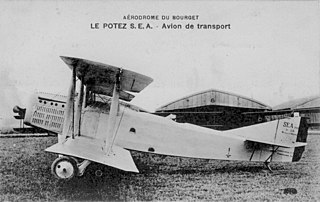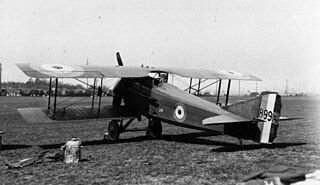Related Research Articles

The SEA IV was a French two-seat military aircraft of World War I and the immediate post-war era.

The SPAD S.VII was the first of a series of highly successful biplane fighter aircraft produced by Société Pour L'Aviation et ses Dérivés (SPAD) during the First World War. Like its successors, the S.VII was renowned as a sturdy and rugged aircraft with good climbing and diving characteristics. It was also a stable gun platform, although pilots used to the more manoeuvrable Nieuport fighters found it heavy on the controls. It was flown by a number of the famous aces, such as France's Georges Guynemer, Italy's Francesco Baracca and Australia's Alexander Pentland.

The de Havilland DH.60 Moth is a 1920s British two-seat touring and training aircraft that was developed into a series of aircraft by the de Havilland Aircraft Company.

Between 1920 and 1951 the Société des Moteurs Salmson in France developed and built a series of widely used air-cooled aircraft engines.

The Nakajima Ki-34 was a Japanese light transport of World War II. It was a twin-engine, low-wing monoplane; the undercarriage was of tailwheel type with retractable main units. During the Pacific War, the Allies assigned the type the reporting name Thora.
The Potez XV was a French single-engine, two-seat observation biplane designed as a private venture by Louis Coroller and built by Potez and under licence in Poland.

The Fokker S.IV was a military trainer aircraft produced in the Netherlands in the mid-1920s. It was a conventional, single-bay biplane with staggered wings of unequal span braced with N-struts, essentially a radial-engined development of the S.III. The pilot and instructor sat in tandem, open cockpits and the undercarriage was of fixed, tailskid type with a cross-axle between the main units. The Royal Netherlands Army Aviation Group purchased 30 examples and used them right up to the German invasion of the Netherlands in 1940. On 14 May that year, a few surviving S.IVs escaped to France alongside some S.IX trainers, but never flew again.

The Nieuport 14 was a military reconnaissance sesquiplane produced in France during the First World War. The French Army deployed it in 1916 but the type was quickly withdrawn from front-line service.
German submarine U-486 was a Type VIIC U-boat built for Nazi Germany's Kriegsmarine for service during World War II. She was laid down at the Deutsche Werke in Kiel as yard number 321, launched on 12 February 1944 and commissioned on 22 March with Oberleutnant zur See Gerhard Meyer in command.
The ANF Les Mureaux 140T was a French postal monoplane first flown in September 1932. It was a high-wing monoplane powered by three 120 hp (89 kW) Salmson 9Ac radial engines. It had room for six passengers or four plus freight or mail but it did not enter production.

The SPCA 40T, also designated the SPCA VII, was a mailplane built in France in the late 1920s.

The SPCA Météore 63 was a flying boat built in France in the 1920s for use as an airliner. It was the first product of the SPCA company, founded by Laurent-Dominique Santoni when he left CAMS in 1925.

The Bréguet 410 was a French bomber of the early 1930s. Not many of these twin-engined sesquiwing biplanes were built. At least one Breguet 413, one of its variants, was sold to the Spanish Republican Air Force during the Spanish Civil War.

The Société Provençale de Constructions Aéronautiques (SPCA) was a French aircraft manufacturing company, with its head office in Paris and its workshop in La Ciotat near Marseille.

The SPCA 30, also known as SPCA Type III, was a French bomber aircraft built by the Société Provençale de Constructions Aéronautiques (SPCA).
The S.E.C.A.T.-VI La Mouette or S.E.C.A.T. 60T La Mouette was a French two seat tourer built shortly before the outbreak of World War II.

The Rohrbach Ro VII Robbe was an all-metal, twin engine flying boat built in Germany in the 1920s. It could be adapted to commercial or military rôles.

The SPCA 10 or SPCA Paulhan-Pillard E.5 was a large, all-metal, French reconnaissance and bomber flying boat flown in 1928. Only one was built, and it was lost in a fatal crash during development.
The SPCA 20 was a French seaplane designed for torpedo bombing. It was a low-wing monoplane of all-metal construction.
References
- ↑ Parmentier, Bruno. "SPCA 60T". Aviafrance (in French). Paris. Retrieved 26 February 2019.